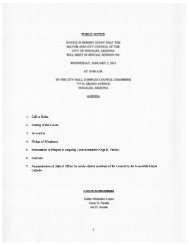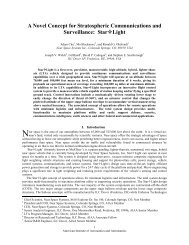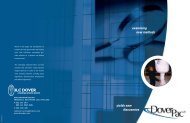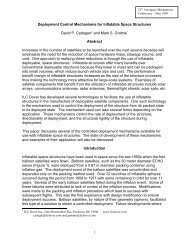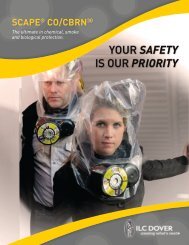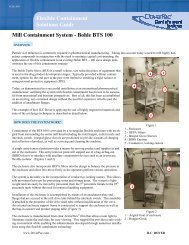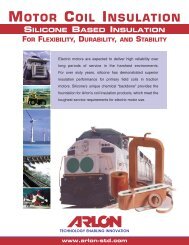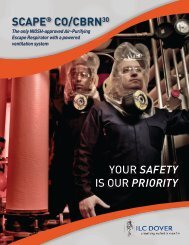Self-Healing Technology for Gas Retention Structures ... - Team-Logic
Self-Healing Technology for Gas Retention Structures ... - Team-Logic
Self-Healing Technology for Gas Retention Structures ... - Team-Logic
- No tags were found...
Create successful ePaper yourself
Turn your PDF publications into a flip-book with our unique Google optimized e-Paper software.
Feed ThroughPortFigure 17. <strong>Self</strong>-healing Viscoelastic Gel Localized onEach Pattern Piece of SSA Lower Arm BladderTwo lower arm bladders, those shown above, wereintegrated with standard SSA lower arm fabric restraintsand installed on hardware <strong>for</strong> pressurization. Both lowerarm restraint and bladder assemblies passed pressuretesting to the SSA structural pressure load at 44.8 kPA(6.5 psi) with acceptable leakage (< 5 sccm). They werethen tested in Chamber N vacuum chamber at JohnsonSpace CenterThe vacuum chamber test was conducted by placing thelower arm restraint/bladder longitudinally centered on thelinear feed through port. A 2 mm puncture probe,identical to the probe used at ILC, was mounted on thefeed through and manually operated. Rate and <strong>for</strong>ce ofpuncture was not controlled but was subjectively quickand <strong>for</strong>ceful. The chamber was operated at 10 -5 torrwhile the lower arm was pressurized to 29.6 kPa (4.3psig). The chamber pressure and bladder pressure andleakage were monitored at 0.1 second intervals. Visualobservation of the puncture site confirmed contact butcould not confirm complete penetration of the bladder.Both bladders were tested using the same procedureand both were punctured in the same location on the<strong>for</strong>earm of the bladder. See Figure 18.Upon initial puncture of the <strong>for</strong>mulation 5 bladder, nodeviation in pressure and no leakage were detected.The puncture was repeated until the third time when adeflection in bladder pressure from 4.3 psig to 4.03 psigwas noted be<strong>for</strong>e re-stabilization at 4.3 psig. Uponconclusion of the test, visual examination verifiedcomplete penetration of the bladder at the puncture site.Formulation 1 bladder was similarly punctured threetimes be<strong>for</strong>e loss of pressure. In this case however, thebladder did not re-stabilize at 4.3 psig. The test wasconcluded and visual examination of the bladder verifiedcomplete penetration of the bladder and sealing agent inplace. Visual examination then revealed the unusual andun<strong>for</strong>tunate finding that an O-ring seal on the test plughardware had split resulting in the leakage. The test wasnot continued.Puncture ProbeAlignment on Un-InflatedComponentFigure 18. Vacuum Chamber Test on <strong>Self</strong>-healing LowerArm BladderIn the most recent study, instead of the viscoelastic gel,used in the earlier work, another material was producedand tested. In these samples, the de<strong>for</strong>mable materialwas cast as a film and laminated to one of itsencapsulating fabrics. The Sample JY49B was arelatively stiff film in that it did not outwardly demonstratea flowing response to slight pressure. The JY49B filmwas encapsulated between two layers of a .051 mmpolyurethane film, .508 mm (20 mil) total. Anothersample, JY49F, was a less viscous film and wasencapsulated between one layer of the .051 mmpolyurethane film and a .127 mm polyurethane coatedpolyester ripstop fabric, .584 mm (23 mil) total. Therationale behind the different configurations was todemonstrate the effect and expected contribution of thestiffer fabric matrix compared to that of the thin film <strong>for</strong>improved sealing capacity.Samples were placed under a fabric restraint andinstalled into a self-healing test fixture in a vacuumchamber at ILC Dover that allowed <strong>for</strong> pressurizationagainst the “bladder” and vacuum on the opposite side.Figure 19 shows the ILC vacuum chamber and testfixture. The test fixture was pressurized to 29.6 kPa (220torr) to simulate a space suit inflatable and 65.5 kPa (491torr) to simulate a habitat inflatable while under vacuumat 10 -5 torr. During test, the <strong>for</strong>ce of puncture, flow rate,and time in seconds to achieve a seal were monitoredand recorded. Figure 20 shows the results of puncturetests on both the JY49B and JY49F samples.



